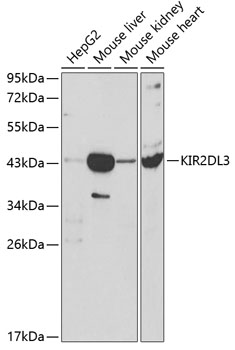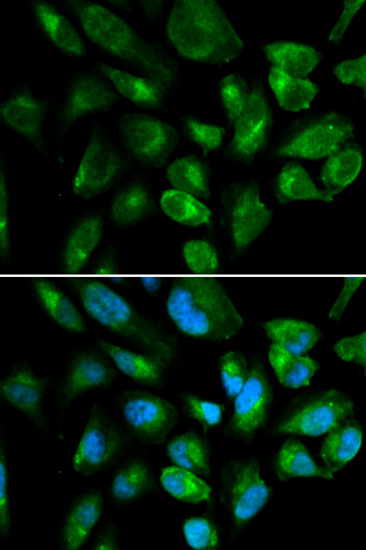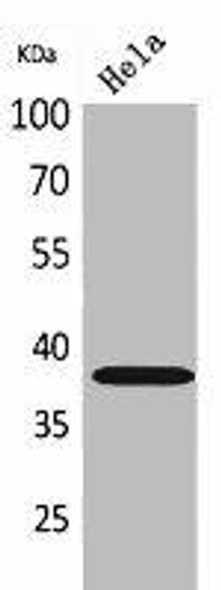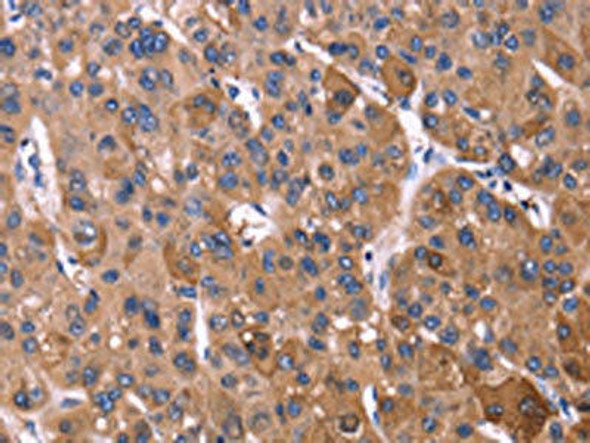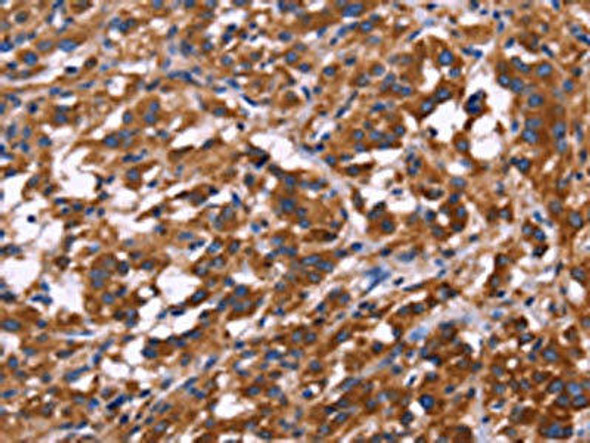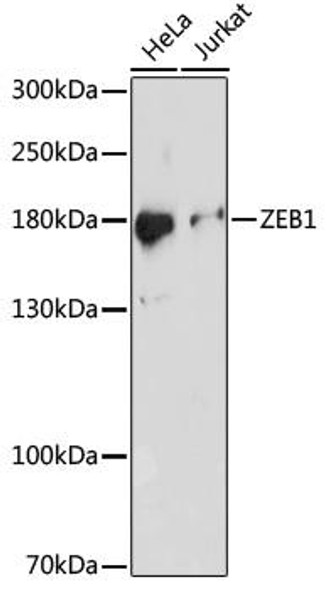Anti-KIR2DL3 Antibody (CAB1698)
- SKU:
- CAB1698
- Product type:
- Antibody
- Reactivity:
- Human
- Mouse
- Host Species:
- Rabbit
- Isotype:
- IgG
- Antibody Type:
- Polyclonal Antibody
- Research Area:
- Cell Biology
Frequently bought together:
Description
| Antibody Name: | Anti-KIR2DL3 Antibody |
| Antibody SKU: | CAB1698 |
| Antibody Size: | 20uL, 50uL, 100uL |
| Application: | WB IF |
| Reactivity: | Human, Mouse |
| Host Species: | Rabbit |
| Immunogen: | Recombinant fusion protein containing a sequence corresponding to amino acids 22-245 of human KIR2DL3 (NP_056952.2). |
| Application: | WB IF |
| Recommended Dilution: | WB 1:500 - 1:2000 IF 1:50 - 1:200 |
| Reactivity: | Human, Mouse |
| Positive Samples: | HepG2, Mouse liver, Mouse kidney, Mouse heart |
| Immunogen: | Recombinant fusion protein containing a sequence corresponding to amino acids 22-245 of human KIR2DL3 (NP_056952.2). |
| Purification Method: | Affinity purification |
| Storage Buffer: | Store at -20°C. Avoid freeze / thaw cycles. Buffer: PBS with 0.02% sodium azide, 50% glycerol, pH7.3. |
| Isotype: | IgG |
| Sequence: | HEGV HRKP SLLA HPGP LVKS EETV ILQC WSDV RFQH FLLH REGK FKDT LHLI GEHH DGVS KANF SIGP MMQD LAGT YRCY GSVT HSPY QLSA PSDP LDIV ITGL YEKP SLSA QPGP TVLA GESV TLSC SSRS SYDM YHLS REGE AHER RFSA GPKV NGTF QADF PLGP ATHG GTYR CFGS FRDS PYEW SNSS DPLL VSVT GNPS NSWP SPTE PSSE TGNP RHLH |
| Gene ID: | 3804 |
| Uniprot: | P43628 |
| Cellular Location: | Cell membrane, Single-pass type I membrane protein |
| Calculated MW: | 27kDa/37kDa |
| Observed MW: | 45kDa |
| Synonyms: | KIR2DL3, CD158B2, CD158b, GL183, KIR-023GB, KIR-K7b, KIR-K7c, KIR2DS5, KIRCL23, NKAT, NKAT2, NKAT2A, NKAT2B, p58 |
| Background: | Killer cell immunoglobulin-like receptors (KIRs) are transmembrane glycoproteins expressed by natural killer cells and subsets of T cells. The KIR genes are polymorphic and highly homologous and they are found in a cluster on chromosome 19q13.4 within the 1 Mb leukocyte receptor complex (LRC). The gene content of the KIR gene cluster varies among haplotypes, although several 'framework' genes are found in all haplotypes (KIR3DL3, KIR3DP1, KIR3DL4, KIR3DL2). The KIR proteins are classified by the number of extracellular immunoglobulin domains (2D or 3D) and by whether they have a long (L) or short (S) cytoplasmic domain. KIR proteins with the long cytoplasmic domain transduce inhibitory signals upon ligand binding via an immune tyrosine-based inhibitory motif (ITIM), while KIR proteins with the short cytoplasmic domain lack the ITIM motif and instead associate with the TYRO protein tyrosine kinase binding protein to transduce activating signals. The ligands for several KIR proteins are subsets of HLA class I molecules; thus, KIR proteins are thought to play an important role in regulation of the immune response. |
| UniProt Protein Function: | KIR2DL3: Receptor on natural killer (NK) cells for HLA-C alleles (HLA-Cw1, HLA-Cw3 and HLA-Cw7). Inhibits the activity of NK cells thus preventing cell lysis. Belongs to the immunoglobulin superfamily. 2 isoforms of the human protein are produced by alternative splicing. |
| UniProt Protein Details: | Protein type:Receptor, misc. Chromosomal Location of Human Ortholog: 19q13.4 Cellular Component: integral to plasma membrane; integral to membrane; plasma membrane Molecular Function:protein binding; receptor activity; antigen binding Biological Process: regulation of immune response; immune response |
| NCBI Summary: | Killer cell immunoglobulin-like receptors (KIRs) are transmembrane glycoproteins expressed by natural killer cells and subsets of T cells. The KIR genes are polymorphic and highly homologous and they are found in a cluster on chromosome 19q13.4 within the 1 Mb leukocyte receptor complex (LRC). The gene content of the KIR gene cluster varies among haplotypes, although several "framework" genes are found in all haplotypes (KIR3DL3, KIR3DP1, KIR3DL4, KIR3DL2). The KIR proteins are classified by the number of extracellular immunoglobulin domains (2D or 3D) and by whether they have a long (L) or short (S) cytoplasmic domain. KIR proteins with the long cytoplasmic domain transduce inhibitory signals upon ligand binding via an immune tyrosine-based inhibitory motif (ITIM), while KIR proteins with the short cytoplasmic domain lack the ITIM motif and instead associate with the TYRO protein tyrosine kinase binding protein to transduce activating signals. The ligands for several KIR proteins are subsets of HLA class I molecules; thus, KIR proteins are thought to play an important role in regulation of the immune response. [provided by RefSeq, Jul 2008] |
| UniProt Code: | P43628 |
| NCBI GenInfo Identifier: | 1171727 |
| NCBI Gene ID: | 3804 |
| NCBI Accession: | P43628.1 |
| UniProt Related Accession: | P43628 |
| Molecular Weight: | 45kDa |
| NCBI Full Name: | Killer cell immunoglobulin-like receptor 2DL3 |
| NCBI Synonym Full Names: | killer cell immunoglobulin like receptor, two Ig domains and long cytoplasmic tail 3 |
| NCBI Official Symbol: | KIR2DL3 |
| NCBI Official Synonym Symbols: | p58; NKAT; GL183; NKAT2; CD158b; KIR2DL; NKAT2A; NKAT2B; CD158B2; KIR-K7b; KIR-K7c; KIR2DS5; KIRCL23; KIR-023GB |
| NCBI Protein Information: | killer cell immunoglobulin-like receptor 2DL3 |
| UniProt Protein Name: | Killer cell immunoglobulin-like receptor 2DL3 |
| UniProt Synonym Protein Names: | CD158 antigen-like family member B2; KIR-023GB; Killer inhibitory receptor cl 2-3; MHC class I NK cell receptor; NKAT2a; NKAT2b; Natural killer-associated transcript 2; NKAT-2; p58 natural killer cell receptor clone CL-6; p58 NK receptor CL-6; p58.2 MHC class-I-specific NK receptor; CD_antigen: CD158b2 |
| Protein Family: | Killer cell immunoglobulin-like receptor |
| UniProt Gene Name: | KIR2DL3 |
| UniProt Entry Name: | KI2L3_HUMAN |


